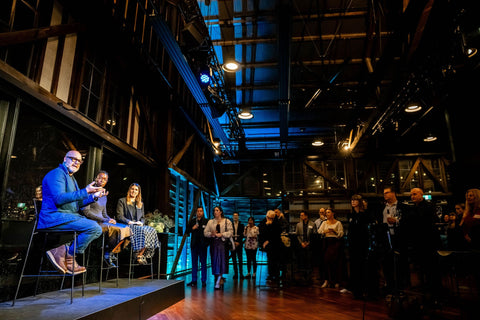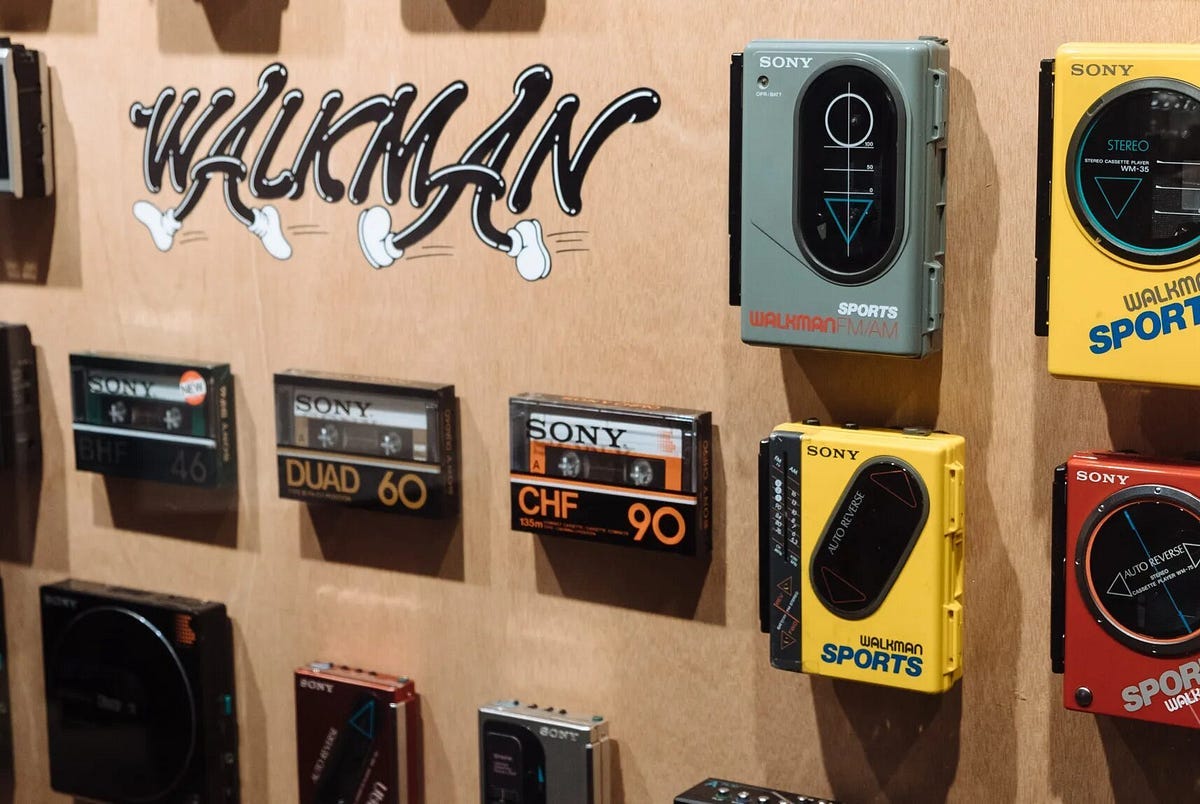
Why the U.S. Must Fix Its Design Problem to Build a Better Future.
Disconnected by Design:
In February 1988, just before my 13th birthday, my mum and dad surprised me with a bright yellow Sony Walkman. It was a treat, they said…

In February 1988, just before my 13th birthday, my mum and dad surprised me with a bright yellow Sony Walkman. It was a treat, they said, so I could listen to music during our long car ride to World Expo 88 in Brisbane after Easter the same year. I can still remember the thrill of holding it for the first time. It felt like a glimpse into another world where I controlled the soundtrack. Its bright casing practically glowed in my hands, and the foam earphones, soft and unassuming, hinted at the promise of something extraordinary. Remember the first time you strapped a Walkman to your belt and let the earphones hang around your neck? Rad right? So Rad!
I remember peeling back the packaging with awe and impatience, the first click of the cassette door opening as satisfying as the sound of a tear on a packet of Hubba Bubba. Sliding tape into the deck became a ritual. To hear my favourite song, remember, we had to fast-forward, press stop, adjust, and rewind if we went too far. It wasn’t quick, but that was the point. Every step connected us to the music. It wasn’t just intuitive — it was alive as if the device and we were connected, one part technology, one part human, in coherence, working seamlessly. It felt powerful, a feeling I’ve never forgotten.
That yellow Walkman still sits in my office drawer, tucked away like a relic of another era or a connection to the past. It’s not functioning anymore — the foam on the earphones has crumbled, and the rubbery buttons are worn — but I could never part with it. It is a loving reminder of a time when design was a balance of utility and creating a connection. The Walkman didn’t just play music; it became part of your identity. It was personal, like an old pair of shoes.
Designed by Nobutoshi Kihara, the Walkman was revolutionary, changing how we experienced music. For the first time, we could carry a soundtrack to our lives in our pockets, creating moments and memories shaped by sound. It bridged the gap between the communal music experience — blaring from a stereo or shared at a concert — to the deeply personal experience of listening to Cindy Lauper on the go. (I had a lifelong infatuation with Cindy Lauper; as a 13-year-old, listening to Cindy when my friends were rocking out to Bon Jovi was a lifeline from a lifetime of teenage bashing). To learn more about Cindy’s story and how she inspired so many chapters of my life, you need to pre-order a copy of my book, Lessons in Creativity, here. But for now, back to the story!
Every time we slip on headphones or queue up a playlist, we’re living in the legacy of the Walkman. It was a product and an experience — a perfect example of behavioural design before anyone had a name for it. It wasn’t just designed to function; it was designed to work beautifully and make us feel something (in my case, it lasted a lifetime). And for most decades later, it still does
The way we interact with technology today is unrecognisable from the days of the Walkman. We’ve moved from tactile dials and buttons to seamless touchscreens, from cassette tapes to streaming services that serve up entire discographies with a single tap. We don't even need to think. We’ve traded the deliberate rituals of analog for the speed and convenience of digital. But in this pursuit of efficiency, we’ve lost something critical: the human connection that made those analog experiences so powerful.
Technology has become embedded in nearly every part of our lives. Yet, the way it’s designed often feels cold and impersonal. Too often, we prioritise what technology can do — its functionality — over how it makes us feel — its design! This is where user experience (UX) and behavioural design come in, and their absence can be felt most acutely in the United States.
UX design is more than making systems easy to use; it creates intuitive and enjoyable interactions. It considers users’ needs, preferences, and behaviours, building systems that feel natural rather than overwhelming. Behavioural design goes even deeper, focusing on how humans think and act. It’s about guiding people’s choices and actions through thoughtful design, reducing friction, and fostering trust. These principles are why great design doesn’t just work — it resonates.
But the U.S. has a problem. Despite being a global leader in technological innovation, the country often neglects UX and behavioural design, especially in its government systems. Let’s be honest — aside from the obvious exceptions (the big tech brands), most websites and digital platforms here suck ****. Over the past three months, I’ve interacted with government agencies, organisations, brands, and colleges across the U.S.; the pattern is undeniable. No one “seems” to give a **** about design on the client side. From outdated websites to interfaces that feel like relics of the early 2000s, the systems meant to serve millions are among the least user-friendly.
This isn’t just a technical flaw — it’s a systemic issue. And it’s especially glaring in a country with ambitions as grand as landing on Mars (or, as recent declarations suggest, planting flags in all kinds of places, even those that aren’t theirs). If the U.S. envisions a future built on technology, that technology needs to work for the people who use it. Right now, it doesn’t.
Technology Without Connection
The U.S. government’s digital systems offer a stark lesson in what happens when technology prioritises functionality over usability. These websites and services — the portals millions rely on daily — are clunky, frustrating, and painfully outdated. If you’ve ever navigated a voter registration site (I haven't, but I have read a lot about it), renewed a car registration online, or applied for any assistance through a government site, you’ve likely felt the pain. It’s not just that these systems feel old; they feel indifferent.
This indifference came into sharp focus In 2020 when millions of Americans encountered obstacles when trying to register to vote or update their voter information online. Confusing layouts, outdated interfaces, and inconsistent navigation plagued many state websites. Finding the right form, filling it out correctly, and submitting it was reportedly like solving a puzzle without instructions. This complexity was discouraging for first-time voters — and for many, it became a barrier to participating in democracy.
I have also heard young people curse the rollout of unemployment benefits during economic downturns, exposing the cracks in digital design. Overloaded websites, unclear instructions, and frequent crashes turned a lifeline for millions into a source of frustration. People in desperate need of support were left refreshing pages endlessly or sitting on hold for hours, all because the systems were poorly designed for real-world use.
When systems are challenging to use, they don’t just create friction; they create barriers. People feel excluded, unimportant, and even distrustful. And this isn’t a one-off problem. While the challenges of poorly designed systems are global, they’re particularly stark in the U.S., which champions itself as a leader in technology and innovation. The irony is hard to miss: a nation that excels at building the future of technology has overlooked the essential connection between its tools and its people.
It’s as if the U.S. is obsessed with technology but has forgotten the most important question: How do we ensure it serves the people who use it? When design is treated as an afterthought, the result isn’t just bad technology — it’s alienation, frustration, and, in critical moments, harm.
My Sony Walkman was joyful. Every detail, from the tactile click of its buttons to the smooth motion of the cassette door, felt intuitive and considered. Its simplicity made you feel connected and independent, with a sense of belonging (Community).
Good design, whether analog or digital, builds trust. It creates an experience that feels empowering, intuitive, and delightful. That’s the essence of behavioural design: it’s not just about how something works but about how it aligns with how people think, feel, and act. It’s the art of meeting people where they are, reducing friction, and fostering connection.
But somewhere along the way, we’ve lost sight of this. With their endless menus and overcomplicated interfaces, today’s digital systems lack the emotional resonance that made analog design so impactful. They’re often cold, transactional, and indifferent to the human experience. In the rush to digitise everything, we’ve stripped away the essence that made those analog interactions meaningful: the human touch.
The analog world wasn’t perfect, but it offered lessons we can’t afford to forget. When design prioritises simplicity, clarity, and connection, it doesn’t just work better — it feels better. And that feeling keeps people coming back, engaging deeply, and trusting the systems they rely on.

The Role of Behavioral Design
Behavioural design is about understanding people — how they think, what they fear, and what they truly need — and designing systems that meet them exactly where they are. It’s the difference between a healthcare portal that frustrates users into giving up and one that provides reassurance in a moment of vulnerability. It’s what transforms a voter registration site from a bureaucratic nightmare into a seamless, empowering experience. A well-designed system should reassure us of our place and voice in a democracy — making it clear that our vote matters. Access to that vote should be simple, clean, and fair, reflecting the trust and inclusivity that good design can foster.
At its core, behavioural design is about equity. Poorly designed systems create inconvenience and exclusion. They disproportionately affect those who lack the time, skills, or resources to navigate clunky interfaces — the people who often need these systems the most. When design fails them, it reinforces existing inequalities, creating barriers where there should be bridges.
Yet, one of the most persistent misconceptions about behavioural design is that it’s optional — a “nice-to-have” rather than a fundamental requirement. When systems are complex, people don’t use them. And when people don’t use them, those systems fail, no matter how advanced the technology behind them might be.
Behavioural design assists in creating technology that serves its purpose and the people who use it. That requires empathy, intention, and a commitment to putting users — not just functionality — at the heart of the design process.
As an Australian temporarily living in the U.S., I’ve been struck by the sheer fragmentation of its government and digital systems. In Australia, platforms like myGov offer a unified gateway to essential services — taxation, healthcare, and welfare — making it easier for citizens to navigate their lives. While it’s far from flawless, it reflects an intentional effort to streamline public services under one cohesive structure.
By comparison, U.S. government websites feel scattered and disconnected. Each department seems to operate in its silo, with its own platform, logic, and design quirks. In the United States, there isn’t a direct equivalent to myGov. Instead, U.S. citizens typically interact with federal and state services through individual agency websites, each with its own login systems and interfaces. For example, Social Security, Medicare, and the Internal Revenue Service (IRS) operate separate online portals. For the average citizen, this means navigating an overwhelming maze of portals, each requiring its account, instructions, and patience. There’s no consistency, central hub, and sense of a unified system designed with the user in mind.
This lack of cohesion symbolises deeper inefficiencies in delivering public services. Every clunky interface and error-prone process reinforces a frustrating reality: the system wasn’t designed for the people it’s supposed to serve. It’s as though functionality has been prioritised over humanity, leaving users feeling like an afterthought in a machine built for bureaucracy rather than people.
The solution isn’t just better websites; it’s a systemic reimagining of how public services are designed and delivered. A single, cohesive platform for essential services — one that prioritises behavioural design — would improve accessibility and foster trust and inclusion. The U.S. can do the same if Australia can create a unified system with fewer resources. What’s needed is the will to prioritise people over processes.
The Future of Design
The future of design is about creating systems that serve people, sustain the planet, and strengthen the ecosystems we all rely on. This is the essence of Orbital Design — an approach that acknowledges the interconnectedness of everything we create and ensures that no solution exists in isolation.
Design must evolve to reflect the complexity of the world we live in. It’s no longer enough to design for people without considering the systems that shape their lives or the planet that sustains them. Orbital design offers a framework to navigate this complexity, balancing the needs of individuals with the broader implications of our choices. It’s about designing in harmony, where solutions benefit all three dimensions — people, planet, and systems. Otherwise known as the Systemic Design Foundation (you can thank me later)!
Behavioural design remains at the heart, helping us understand how people think, feel, and act. By integrating these insights, we can create solutions that work and guide people toward sustainable and equitable choices. However, Orbital Design extends this thinking further. It doesn’t just ask, “How do we design for people?” it also considers “How do we ensure this design positively interacts with the systems and resources it depends on?”
For example, a well-designed digital platform isn’t just intuitive for users; it also considers its environmental impact, ensuring it’s energy-efficient and powered by renewable resources. A public transit system isn’t just convenient; it’s part of a broader effort to reduce emissions, ease urban congestion, and connect communities. Every solution becomes part of a larger, regenerative cycle.
The future of design demands that we stop choosing between people, planets, and systems. Inclusive design means recognising that these elements are interconnected — and always have been. It’s about alignment: finding the sweet spot where innovation serves humanity, respects the environment, and strengthens the systems that hold it together.
Orbital design provides a pathway forward. It shifts us from thinking in silos to seeing the bigger picture, from creating isolated solutions to building integrated ecosystems. The future of design isn’t about what’s next — it’s about what endures. And for design to endure, it must work in service of something greater than itself: a thriving, connected world.
Lessons for the U.S. Government
1. Put People at the Centre: The design begins with empathy. Understand the people you’re designing for — their frustrations, fears, and needs. Engage with communities, listen to their experiences, and let those insights shape the solutions. A human-centred approach isn’t just a strategy; it’s a responsibility.
2. Simplify, Don’t Overwhelm: Complexity creates barriers. Strip systems down to their essentials, focusing on intuitive experiences that guide users effortlessly. Whether it’s a government website or a public service portal, simplicity fosters confidence and trust, turning frustrating interactions into empowering ones.
3. Lead with Purpose: A unified vision for user experience requires leadership. Appointing a Chief Experience Officer (CXO) or a similar role can ensure consistency across government platforms. This isn’t about bureaucracy; it’s about prioritising design and ensuring every interaction reflects a commitment to usability and accessibility.
4. Learn from the Best: The private sector understands behavioural design's value. Brands like Apple and Nike don’t just sell products; they create experiences that build trust and foster community. Governments can adopt these principles, ensuring their systems are more than functional — meaningful.
5. Design for Connection: Good design isn’t just functional; it’s emotional. It creates trust, fosters belonging, and makes people feel seen and valued. Government systems should go beyond efficiency to develop emotional connections that inspire confidence and loyalty. When people trust the systems they rely on, they’re more likely to engage fully and effectively.
Sometimes, I take out old records, placing the needle on the vinyl and letting the warmth of analog sound fill the room. Living in the U.S. for the past 3 months and on and off for the past decade, I’ve been fascinated by the resurgence of cassette tapes and records among young people. Record stores are thriving, bustling with communities rediscovering the tactile, intentional experience of analog. These formats endure because they’re nostalgic and offer something digital often lacks — a sense of connection, ritual, and meaning.
As digital technology continues to evolve, its challenges are becoming more evident. It’s overwhelming and noisy and often feels disconnected from the human experience. People will always seek moments to unplug, but it becomes something else entirely when a digital design is seamless, thoughtful, and human. It doesn’t compete with our lives — it enhances them.
The Sony Walkman taught me that great design is rarely about function but how it makes you feel. That lesson is just as important today as it was decades ago. The U.S. has the resources, talent, and vision to lead the world in technology, but it’s falling behind in UX and behavioural design. In a world where technology has become the bridge to almost every part of life, the cost of neglecting design is steep.
The future of technology is not just about speed, power, or innovation. It’s about connection, intention, and humanity. That’s the role of design: to bring us closer to each other, to our environment, and to the systems that sustain us. If we get it right, the digital future will be more than just more advanced; it will be more human.


